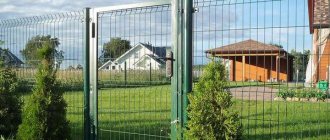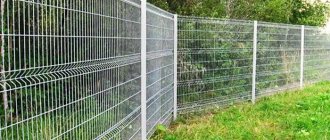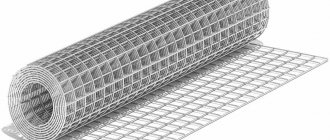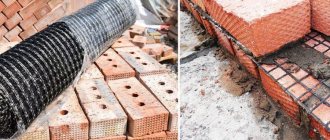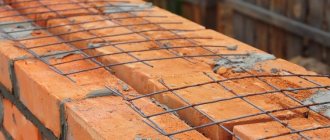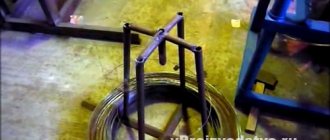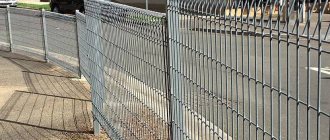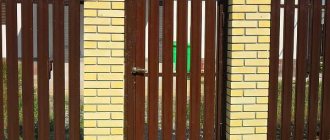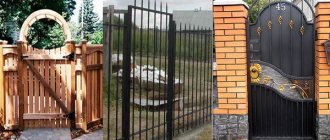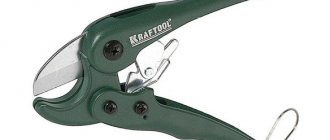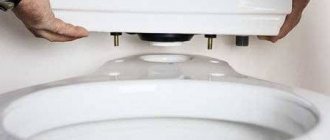Galvanized mesh for fences
Fences made from mesh are very popular; they are indispensable in cases where you need a reliable fence with good light transmission and a low price. In addition, modern fences made of welded galvanized mesh are very attractive, durable and easy to install with your own hands.
Classic country fence made of galvanized welded mesh
Advantages of galvanized mesh
They produce galvanized mesh from metal wire. Its rods are arranged perpendicularly and are fastened at the connection points by welding. The cells of the welded mesh are made rectangular, square, less often diamond-shaped, trapezoidal or other shapes.
The wire for the mesh is galvanized or with an additional polymer coating. Fencing made of welded galvanized mesh has its advantages:
- Affordable price;
- Simple and quick installation of the mesh can be done with your own hands;
- Light weight, does not require foundation construction;
- Transparency and good visibility allow it to be used at protected sites;
Fence design made of galvanized mesh and metal corners
Self-attachment of chain-link mesh to a metal pole
Before attaching the chain-link mesh, you need to drill a hole in the pipe and cut the thread. To do this you will need a steel strip 4X20 mm.
Before thoroughly attaching the chain-link mesh using a hacksaw or grinder, it is necessary to prepare sections of 150-200 mm. With their help we will attach the chain-link mesh. We drill 2 holes in them with dimensions similar to those in the pipes.
Recommendation! Drilling iron structures is best done at reduced drill speeds.
Next, threads are cut for the bolts. Then we unfold the chain-link mesh and press it with plates to the post, fixing it at the top and bottom. Tighten the bolt nuts until they stop.
Ideally, they can be riveted at the finish. The work can be completed by 2 people, but installation will be more fun and faster if 3 people work.
If this option seems labor-intensive, you can attach the mesh by welding. The plates are fixed at the corners to the pipes, then the mesh is attached.
It is important to ensure tension across these posts, minimizing sagging.
For these purposes, a 6 mm cable, which is attached to the corner posts, is ideal. The tension is adjusted using bolts. It is clear that through holes must first be made in the pillars themselves.
Note! Using welding is the most effective way to attach chain-link mesh to supports.
The result of the “labor feat” will be clearly visible in winter, when snow falls on the fence. Nature itself will check the reliability of fastening the chain-link mesh.
About mounting options
There are many mounting options. But when using chain-link mesh, it is best to install individual sections. For this purpose, frames from a metal corner are made in advance. The mesh is attached to them (welded).
Mesh fence diagram
As a result, all that remains is to fix the individual sections on the poles. In this case, you do not need to worry about the structure (fence) sagging. If repairs are required, you can easily dismantle the damaged element: section.
Please note! When fastening a chain-link mesh sectionally, the main thing is to comply with the dimensions of the frames.
Failure to maintain identical dimensions will result in the fence becoming lopsided; pay special attention to this.
To understand how to secure the mesh yourself, we recommend that you watch this video:
Types of welded mesh fences
Depending on the type of coating, welded mesh fencing is available in the following types:
- Non-galvanized mesh. The simplest version of a mesh welded from steel wire with a diameter of 1.2–10 mm. It has a low price and is susceptible to corrosion.
- This mesh will have to be painted periodically to improve its appearance and provide additional protection.
Rolls of non-galvanized mesh size 50x50 Also, galvanized mesh can be produced in the following types:
Drawing of a section of a fence made of galvanized mesh
- Galvanized mesh in rolls. The weight of the roll can be from 50 to 500 kg. The height of a fence made of rolled mesh is available up to two meters. The length of the mesh in the package can be from 15 to 33 m.
- Sectional (quick-release) fence mesh. Such a fence can be assembled very quickly with your own hands. The welded mesh is placed in a rectangular frame made of a profile pipe or angle. A fence made of sections is more durable and attractive. Sectional fencing is the most in demand both in urban environments and in the private sector.
- Decorative welded mesh 3D for fences. A new type of galvanized fence made of welded sections. How to attach a gate to a brick pillar? The design is made of curved rods that create a three-dimensional effect; it looks very unusual and beautiful. This version of the fence uses a PVC layer and decorative wavy sections along the edges or in the middle of the canvas. Another option is made in the form of twisted and corrugated wires.
Decorative fencing made of welded mesh can often be seen around city parks; it looks organic in combination with the vegetation around playgrounds and private cottages.
Return to contents
Types of mesh fences
It is necessary to divide the mesh into two groups, differing from each other in the source material. These are metal mesh and plastic. The latter are rarely used for fencing areas because they do not have sufficient strength. They are used for fencing flower beds, garden plantings and other structures.
In this regard, metal fencing structures made of mesh are used everywhere. Because they have high technical and operational characteristics. Today, two types of mesh are used for fencing: chain-link and welded.
They differ from each other in manufacturing technology. The first is made by weaving with the formation of cells, the second by spot welding, in which metal rods are connected.
It cannot be said that welded mesh is better than chain-link. Both have fairly high strength characteristics and almost identical advantages and disadvantages.
Advantages and disadvantages of welded mesh
The main advantage of fences made of welded mesh is low price with high technical characteristics. Next we note:
- the ability to dismantle the mesh and use it in another place for the construction of fences or other needs;
- ease of installation;
- a huge variety of sizes offered, which makes it possible to build fences of different heights;
- easily tolerates natural stress;
- transparency of the structure, allowing air and sunlight to pass through, which is an important factor for some areas.
Regarding the shortcomings, many regard the last plus as a minus. Not everyone likes having their personal life wide open. And the transparent design contributes to this. The second negative is that the appearance is not entirely presentable when compared with other fencing structures, for example, brick, stone or wood.
Not the most presentable appearance
Varieties
The classification of welded mesh is based on the source material. There are three categories:
- Made from carbon steel without protective coatings. It is welded from metal rods with a diameter of 1.2-10 mm. Such products are susceptible to metal corrosion, so they become rusty over time. This type of metal mesh must be painted to reduce wear. Painting is carried out with enviable frequency, which increases the cost of maintaining the enclosing structure.
- Galvanized. It is welded from galvanized wire, which practically does not rust under the influence of natural loads. It has a fairly long service life; there is no need to paint such a product. Still, it's not the best material.
- Not galvanized with polymer coating. In fact, this is the first option that is coated with a polymer layer. The finished mesh is simply dipped into the polymer mass and then dried. To give the product a more presentable appearance, it is coated with paint using powder technology. This further increases the protective qualities.
- Galvanized with a polymer layer. This is the pinnacle of metal mesh quality, but also the pinnacle of price. Welded mesh of this type can be classified as materials in the category with an unlimited service life, although manufacturers guarantee 65 years. At the same time, this type of material can easily withstand temperatures ranging from -55C to +65C and humidity not exceeding 97%.
Note that welded meshes are processed with zinc using two technologies. The first is the production of a mesh product from galvanized wire, the second is from carbon steel, and the finished mesh is galvanized. The latter option is better because in the first technology, welding heats the zinc layer of the two rods, which reduces the protective characteristics of the material. Often the zinc layer simply peels off from the base metal body.
In the construction market, welded mesh is presented in two positions: rolled and in the form of layers. The second option is easier to install, because it is a ready-made product with its own dimensions, under which you simply need to install support posts in increments equal to the width of the layer.
Galvanized fence with white polymer coating
How to choose a galvanized welded mesh fence
- The first thing you need to pay attention to is the wire thickness and dimensions. The larger the diameter of the rod and the smaller the mesh, the stiffer the structure of the galvanized fence will be. Such a fence will have a higher price, because more material is spent on the mesh;
- Choice of canvas sizes. Depending on the desired height of the fence, you can select a galvanized mesh from 0.5 to 2 m, the length of the mesh in a roll is from 15 to 33 m. Dimensions of the mesh fence section: height - 2 m, length - up to 2.5 m;
- The ends of the wire should have an even cut or bend. There should be no cracks or damage. A mesh produced in violation of technology is unlikely to last long;
- The cells must have the correct symmetrical shape, and the dimensions must correspond to the parameters declared by the manufacturer;
- Polymer-coated mesh should not have any damage to the protective layer; you should especially carefully inspect the bends if you purchase the mesh in a roll.
What types of mesh are there?
Welded mesh fencing can have different mesh sizes, wires and overall section dimensions. There are several types of wire, and the method of making the mesh also varies.
Main settings
The strength of the fabric is determined by two characteristics: the dimensions of the cage and the diameter of the wire. The smaller the cell of the mesh material, the stronger the fence will be. But material with such parameters costs more. Standard cage: 50x50 mm, 100x100 mm (the most common), as well as 150x150 mm, 200x200 mm. Metal mesh can be light or heavy, which is determined by the thickness of the wire.
In the first case, the diameter varies between 3-6 mm. Heavy fencing is erected using mesh material with a wire thickness of 8 to 40 mm. Section dimensions (standard sizes): 1000x2000 mm, 1500x3000 mm, 2000x3000 mm.
Types of mesh
There are several types of mesh material made by contact welding:
- Non-galvanized - without coating, made using black steel wire;
- Galvanized - during production, wire without special protection or galvanized material is used, respectively, in the first case, the anti-corrosion coating is applied after the fabric is manufactured;
- Polymer mesh - the finished structure is coated with polymers; both galvanized and non-galvanized wire can be used as a base.
The scope of application of these varieties: strengthening the road surface and other structures, wall decoration, construction of fences. Polymer mesh has proven itself well in domestic conditions - it is used to build fences.
Galvanized material with a polymer coating has the best characteristics: a sectional fence will last longer thanks to double protection against corrosion, and it is more attractive in appearance.
Positive qualities of welded mesh fencing
It is necessary to highlight the light transmittance of the structure. This feature allows you to set up a garden or vegetable garden next to the fence, since the mesh eliminates the possibility of shading the area. Installing a fence yourself is faster and easier than most other analogues (made of decorative bricks, natural stone). And the cost of the fence is lower.
Features of installing a fence made of galvanized mesh
There are two ways to install galvanized mesh:
- Tension of the fabric between the pillars;
- Installation of sections.
The first option is cheaper and easier to do yourself. But the second option is considered more aesthetically pleasing and stronger.
If you do not purchase ready-made welded spans, you will have to make the sections yourself from angles or profiles.
Fence posts can be either wooden or metal. Of course, if you build thoroughly, you should use steel supports with a cross-section from 6 to 12 cm.
Choosing fence posts
It is important to decide on the posts for the future fence. They come in different types and their properties, naturally, are different. The pillars can be divided according to their profile:
- for round ones;
- profile designs: rectangular or square;
- not a standard option.
Round and profile products are more common than non-standard items. It is rare to see a fence with multifaceted posts.
They are more expensive than regular products.
The profile version is considered a more durable product due to the presence of stiffening ribs. Naturally, the cost is higher. Considering the type of product, we choose:
- Between the metal option.
- Reinforced concrete structure.
- Wooden pillars.
- Metal pillars.
Installation of pillars
- Perimeter marking. To ensure that the fence is level, the cord is pulled and the location of the posts is determined. The supports must be located at even intervals of at least 2.5 m.
- Installation of fence posts. Holes 120–150 cm deep are prepared for the pillars, the bottom of the wells is filled with crushed stone and sand 10–15 cm thick.
Each layer is moistened with water and compacted. The pole is installed in the hole, checked for verticality and supported. - Mixing mortar and concreting pillars. Concrete is poured into the well and carefully compacted with a crowbar or reinforcing rod. You can start installing sections and stretching the mesh no earlier than in a week, then the composition will be strong enough.
Return to contents
Cost of galvanized mesh fencing
Galvanized mesh in rolls can be purchased from 200 to 800 rubles. per meter The price depends on the thickness of the wire and the size of the cells and the height of the mesh. The smaller the cells, the higher the cost.
For example, a fence 1.3 m high, with cells 10 x 10 mm and a wire thickness of 1.4 mm, will cost 700–800 rubles. per meter
For one linear meter of galvanized mesh with a polymer coating you will have to pay approximately 900–1200 rubles.
This is what sections of welded mesh look like in a warehouse
Types of chain link
To attach the chain-link mesh to the profile pipe, you need to select the optimal type of mesh material. These products are classified as follows:
- without zinc coating;
- galvanized;
- with PVC coating.
Tension fastening method
In the manufacture of non-galvanized chain-link, wire made of black low-carbon steel without a protective coating, 1 or 5 mm thick, is used. The main disadvantage of such products is their high susceptibility to corrosion and, accordingly, a short service life of 2–3 years. This material is only suitable for installing temporary fencing.
Meshes with zinc and PVC coating have high anti-corrosion properties, therefore they are more in demand. Mesh material is available in various shapes and mesh sizes.
Fence post made of corrugated pipe
The strength of the product is determined by the size of the cells. The smaller they are, the stronger the mesh. The standard hole size of the mesh material used to construct the fence is 40–50 mm.
